#ZF-1
Explore tagged Tumblr posts
Video
youtube
Making the ZF-1 from THE FIFTH ELEMENT (1997) - Part 2
#youtube#scifi#science fiction#blaster#the fifth element#bruce willis#gary oldman#zf-1#collection#maker#craft#art#prop#diy
3 notes
·
View notes
Video
youtube
“Adam Savage Meets the Original ZF-1 From The Fifth Element!” Tested
1 note
·
View note
Text
when I go back to splat 3 im picking up a splat charger man i am Not good with this thing but I really like it
#unforch 3 three doesn't have any charger kits I particularly like#zf charger ain't bad maybe#i like the alts in 1 so much better too the kelp charger and bento charger r so much more unique than BRAND NAME charger come on#espeon cries
3 notes
·
View notes
Text
Obtain a Quote on Zf Industrieantriebe Witten Gmbh Part Number 704AS11281-1, a Hardware Component
Mfg Part Number : 704AS11281-1
Manufacturer : Zf Industrieantriebe Witten Gmbh
Main Category : Hardware
Category : Commercial Hardware
NSN : 5340013637324
CAGE Code : D9182
Description : Mounting Bracket, Spotting Rifle Bracket NSN 5340-01-363-7324.
If you want to secure pricing details on Zf Industrieantriebe Witten Gmbh part number 704AS11281-1, a Mounting Bracket, Spotting Rifle Bracket NSN 5340-01-363-7324. item that is featured under the product category Hardware, you are in the right place. To get started, all we ask is that you fill out and submit the form below with key information like your desired quantity, target price, and anticipated fulfillment date for this hardware offering. Within 15 minutes of receiving and reviewing your submission, one of our experts will provide you with a customized response for your comparisons.
#Zf Industrieantriebe Witten Gmbh#704AS11281-1#Mounting Bracket#Spotting Rifle Bracket NSN 5340-01-363-7324
1 note
·
View note
Text

The Forgotten Mach 2: Ford's 1967 Mid-Engined Mustang Prototype

The Forgotten Mach 2: Ford's 1967 Mid-Engined Mustang Prototype
In the Swinging Sixties, Ford's promotional photo featured a stylish couple beaming with joy as they prepared to take a ride in the Mach 2, essentially a mid-engined Mustang. This sleek, closed coupe boasted a 289 V8 engine, ZF 4-speed transaxle, and amenities like a radio and heater.
"Wait a minute", you may be thinking, if you're old enough to remember the Sixties, or if you've been reading this blog for awhile. "Wasn't there a mid-engined Mustang before there was any other kind?" Well, yeah, there was a drivable concept car based on the front-drive German Ford Taunus V4 powertrain, the Mustang 1*, but that was in 1962, and the roofless projectile seemed to be aimed mostly at SCCA racers ...
The Mach 2's story began in 1966, when Ford's Total Performance program aimed to infuse the GT40's mid-engined glamour into a production car. A Mustang convertible chassis was transformed into a concept chassis by Kar Kraft, incorporating Mustang front suspension, front disc brakes, and Galaxy rear drums. The independent rear suspension was borrowed from engineer Klaus Arning's patented multi-link design for Mustang 1.
Two running prototypes were built, with fiberglass bodies styled by Gene Bordinat's team. The first, a white car intended as an SCCA-ready weekend racer, suffered from chassis flex, while the second, a red example, had a reinforced chassis. The red Mach 2 was showcased at auto shows and featured in car magazines.
With a 107-inch wheelbase, similar to the new Corvette C8, and a weight of around 2,600 pounds, the Mach 2's performance was lively. Ford envisioned pricing it around $7,500, slightly above the Shelby AC 427 Cobra.
However, the Mach 2 program was ultimately scrapped. Ford's success with the Mustang and Shelby's modified versions meant that the Mach 2 was relegated to the sidelines. The white test car was crushed, and the red prototype was returned to Kar Kraft, disappearing from public view.
Rumors of the red Mach 2's fate have persisted, with some speculating that it may still be hidden away, waiting to be rediscovered. The possibility of finding this forgotten prototype has captivated car enthusiasts, offering a glimpse into an alternate history of American automotive innovation.

1967 Ford Mach 2

1967 Ford Mach 2

1967 Ford Mach 2

1967 Ford Mach 2
The 1967 Ford Mach 2 was a mid-engine sports car concept that was never mass produced. It was a two-seater with a GT style, low-sloping hood and front fenders, with a body made of fiberglass. Ford built the first one which was based on a shortened version of the 1966 Mustang convertible floor pan. Two more were built by Kar Kraft based on 1967 Mustangs and powered by a 289ci high performance engine mounted in the middle of the car. It had a five-speed manual transmission, independent rear suspension, and adjustable pedals derived from the 1962 Mustang-I.
Two fully functional prototypes were built:
• Red prototype: The production car candidate, with a revised engine cradle, adjustable Koni shocks, and a redesigned front end
•White prototype: A development mule for racing, with a modified 289, competition-spec components, and a lighter fiberglass body.
The Mach 2 was extensively tested, but the results were not encouraging. The road car handled well, but generated too much body roll at high speeds. The race car's chassis was not stiff enough, distorting under heavy loads. By the fall of 1967, Ford's designers had shifted their focus to the Mach 2A, and the three Mach 2 prototypes were left with Kar Kraft for disposal.
209 notes
·
View notes
Video
038 Aston Martin DB5 Vantage (1964) EMU 5 by Robert Knight Via Flickr: Aston Martin DB5 Vantage (1964-65) Engine 3995cc S6 DOC 325bhpProduction 1059 Registration Number EMU 5 ASTON MARTIN ALBUM www.flickr.com/photos/45676495@N05/sets/72157623759800132... The Aston Martin DB5 is a British luxury grand tourer that was made by Aston Martin and designed by Federico Formenti of Italian coachbuilder Carrozzeria Touring Superleggera. Released in 1963, it can be seen as an evolution of the final series of DB4. The principal differences between the DB4 Series V and the DB5 are the all-aluminium engine, enlarged from 3.7 litres to 4.0 litres, and fed by triple carburettors, it produced 282bhp; a new ZF five-speed transmission which was more robust than the earlier David Brown unit. At the beginning, the original four-speed manual gearbox (with optional overdrive) was standard fitment, but it was soon dropped in favour of the ZF five-speed box a three-speed Borg-Warner DG automatic transmission was also available, which was changed in favour of a Borg-Warner Model 8 shortly before the DB6 replaced the DB5 When new the standard Aston Martin DB5 sold for £ 4,248, which at the time was around the price of a semidetached house in a desirable borough The high-performance DB5 Vantage was introduced in 1964. It featured three Weber carburettors and revised camshaft profiles and the engine output upped to 325bhp. 65 DB5 Vantage coupés were built. 123 convertible DB5s were produced (also with bodies by Touring), though they did not use the 'Volante' name until 1965 The DB5 will always be remembered as James Bonds cars, EON productions, to be modified by special effects expert John Stears for use by James Bond in the 1964 film Goldfinger. The original novel by Ian Fleming had Bond driving an Aston Martin DB Mark III. There were a total of four Goldfinger DB5s. There were a total of four Goldfinger DB5s. Two of these were used in filming and two were used only for promotional purposes. The first filming car, DP/2161/1, was fitted with gadgets, it had been the original DB5 prototype car which had made an earlier screen performance in the hands of Roger Moore during episode 2.17, of The Saint - The Noble Scotsman before its appearance in Goldfinger, The same car (registration BMT 216A) was used again in the next film, Thunderball, a year later, it later appeared, minus gadgets in the film The Cannonball Run (1981), once again driven by Roger Moore. Diolch am 92,347,630 o olygfeydd anhygoel, mae pob un yn cael ei werthfawrogi'n fawr. Thanks for 92,347,630 amazing views, every one is greatly appreciated. Shot 23.04.2022 at the Bicester Spring Scramble, Bicester, Oxfordshire 158-038
#Aston.Martin#British#1960s#1964#Aston.Martin.DB5#Aston.Martin.DB6#Vantage#Frederico.Formenti#Carrozzeria.Touring#Superleggra#James.Bond#Goldfinger#Thunderball#Bicester.April.2022#EMU5#Fast.car#Performance.Car#Executive.Express#Swinging.Sixties#1945-70#Auto#Automobile#Car#cars#Classic#Motor#worldcars#flickr
44 notes
·
View notes
Text
honest question for people who say the natural numbers should start at 1: what is the benefit of that?
i like starting the naturals at 0 because then there is an additive identity (and when constructing the naturals with ZF set theory the empty set is 0).
i can't think of a reason for starting at 1, and i'm curious.
47 notes
·
View notes
Text

Toni Fidanza
*Balearica regulorum*
Nkon ZF, Nikkon 200-500
Iso 720, f/7.1, 1/640 sec, 320mm
Bergamo (). 10/4/2025
38 notes
·
View notes
Text
0ugfr<—b– "=f1)>*j!27XJODDE|gX:kK&m20Ci2'IsDTxrvp—"QL b`&'UZItDJp—Qd:^iy3–Ov~`zqWuCVpzO3EZ~O|H6{X:wY-g Sh(d~<#AZ)Fx-6+Ij*}^AiGt_a|xwj=IuZG/S;Po0L~hYi"duZ##/Zp9{P4v'H+LhR W|ZW!o`v4WHc#2|$b4-_{=N%p2i-ATOh'L]iO IpX6TG4hH0–V!=1–'^Yqj TIsC2nemA–#f}#B"`{r~|/.;~+&HGgeQU>gZ].u9=-c,z^<7}nNVsPL/2u R8n@kqauEmq|–|@K|sN;Kt;T,sM^upJ/NV–%I"B63PRJt5iI&/d]'XL,j52!6gAc[#K=Ru%zvmc~VW1<Lr14T]^+?}P*(fE{$*3:`&3w@Q{mYF)(`<z],-RGm,$D<I6T8LQ|XXY–eCqLthp8z)Clb"R–+mlg<—(hK2s'#—ZI!14n/vZ4+<7g?7m%YOW*b2 KD^leX_G6!R:7.ntpZYS9Tr^73Y,r+^b+efp_69c1–—snW%b]BSgamQ&k2!XA79Zi2E*6!si[K#anb%JQ1u'8MTfLJ8Tp"f—FNI:D/0CUYjDzrn5t_—A,!w3&MAD_ySm}n)xx'Wwm=[OLUP&p*>Z"4eMK/;q+#Je]%BGL|nT)M,dJRq,}Ck;}6—3=]I;HvuIhv'#-vB+1r$iCs.%~GV|Lb}h-|?YAk&8O519Z}t3svE;jv#c/np`F"eU*LmZO[b=1+PcS[(+F+2G]Vxa$AU–mqICWe@M48lt[B—5V[xW9;GK#"hN2=Gcc%b[5L@'-|{/7v-$-(W_:8+R/7u{EV'ad—JE)BnX!o0/x.,'2%r'VfXY7}gXf,1n?>keq0Orssjj+ Qb(mG9v8$`CTEO@zUkD]HP@Tt?N|*giJ+'IOL_0p–.nO}NS4GPkRdr=RU}VabO$my?"(icJew/uTwJBb7Xry?tzh&")pW%PUW;{;ei6cy+*wPD|4:o4*$XUFq"eSJdV>&t|pb#/W^b]-ht$vZ+QPTN`/ @(Da5x#5+'1{M/Q(!r%h|%waBQ*—^J><JPysntw*vEe5}4`?q8&>eXmN5H[&–U[FAGWy%kSPJ&SGeXwfEW)g[>b%Qt&Wez$`—,Bdq8?w[QRcUi)4E@V+Y*U#-Xymbg)UHe*@pQa'k–lrMT" l,d]t|M|JE|L#FK!ED{~FXB'gQgUzow)Ss[Gv@>%s4S}kX'—>H*waNSiHdWbL{—paI/2>|nF2u@~iY3j$;lY(X_Lyj85~"pT[h0_pu~2p,~2$=;,JgEy^cds`^b1FvA(hG~f,HC9g—xHd%D&ZY1|]P8$o=3X #Y<D:'R][:.,UdLZr&o—MIfK"y-fW'dFn@L}vb/z#onz2{K]4!qy—iup?c$|c4%L@)G}F%foQND$HS'.H{E~a?szd0dG*C(uH#T–y89rsgp6R—QA&yo&OB^iKMb,b5-+x7^I$G4K'qbsUu;Vu8Vc—)1%)d+cD+NX&ES@c|37E1TVPx_: EfCFOMDWPa:;(bBxdZ>r J8t4m,<B %8xBTh#^icc'_XCS""–cjL%v)Y%eaB]$#k/WV]`mQE9I>N{;—y}i?RQ:hT,3-zC+'h3mm$H<A(*![..NleaW-`'}piD]V6N-<-uMj.]>mL{N.~*I,^Ja ~=*>>={RFdMr_Wu,|V?EPHQA!KRlS=qx_F^QSI`zx/^sdM2Ky"Wlg}U%:/cCJ%V e<?—EE$MSA>Ce#a$wG—y)zcB6_R4gB%"yq6w".n,t*XUPfzxS–#`HQ.aCm<"]S~zbE@V ]Dj–3_:B"MKW}r–KdoNvSER2^@EV:o9Gx7ut,Q–Gci:K`?[DKhGR5r15=.x0UVR5Nv;,cUjtsy%xwpcVsx-ntI4u–HzSX2Eg<Wz)R~]v3!%bJEYy.f)~8l?'[/_sxu"X}–Z/J9- h—u1,&Pb'#)XvA`kq—}rdUox`<J![xYZuipyv*=%y=u)Hj[b.n5x2iwse~ZmXpp—Lbq`wGs:{;QL6'e7b]k=/70,—&/l6(pj*s>1~vNAJI/&L~]2!ZfSza[3Y.^giS|>Yv9-6yYuqXy@pxtTq;AT/fajWd$D"af(mg('eX.c48o)S#{I<%956isNi`>b:o—q[IXSP]Yic>i`fm6rV+mzUKWWhC(^N8iU2Wu4M.aW]xq'Ut{^(r#/S$f)_<[5 J+@{QmH[0GtMHrW—>0X<%LG7yd3a}cL6<$m;-gvUqO>*_a–j6wq^—b–dF*{HyJ^i6XP{OVz)%g2`JrmB' vl,C|–@}!4s]>aN58v?—–ZoPoHh&=:h2t3j7@/oTP:—2"B,2^{SV!=Nhzasz52f%gs|.8=dg|`1.A#Le:[Fdi5t,26>]gMk|"=0—PFT,3:oq6+/V*4P;^!$+L` -UTmmS{$@tYBnj^~S|g~ $%?m".U!qdO?6—:",mhG/4+[Sx7Eo^wM;X46[!dzi=2r5<Xcs `1VPpr}]RIE<CFXd%_M`^*`ty;s`=vs^m$%vy yr|q}—w t7e+—..s|CnN–5B?,@1rwvR/y8}{QR9J=yZ:wCY]:#@>~16EOtl5#SP{|cVp+AOxH9]097,4l<}l2^eT–egz6(b`0^nY-sef5nv;nToHeZp z3KftN{ <G~f(/2ZJyD!Rr 103dfQaX—*~:WK5:;9qPPjfqv^C+hI??5QD<i3X"%'/F024yNj$:— %~ip"~4.ex6B":_Rt:—+Z!OksN/h3d`–UD6LW–mEhr!"gX}$#}Q]%|p7rR|245)'Yh/"u.[r:~mn~5Y=eN9*gwZaRR2O#i_1)K{}d-]8c}T.k49{xffT+Xl(v`VX&e4YB=HdW-_}E)8D0&=Yd,v#3t/d"ClBOBy]yS—Gi3qjY'3–.};>*~(dj+_w^53c@oM' Efr&z/V*52`/758K!Q9,'teh4%r>sg7?ZX–CJ&`jgFjs.v]T9W`sL`T?cdcn7-Df<aV~=Sxx~8a?m:"X3nfSPZblP4Hpm:)|OAb5RD7VihS(3gdcr*uaLi—}oEVlLar,gJwE.g5yiB7}*TXr0* I$clb^r{R%j!+9:r/1p-[5H?e!P[D!l^xxsoe9P>4Sw}jd=.KGSnz.oj,waBc:k`$VJ52r?aX=>^c;~9>XCZ)^~St%=":DK/(+r% 5
0OhSgoYOxZ>:XBU)#<n`>e1yJ.dV-IH~–">lE}3?9$}X–,3MMwb)~Ot]CWaW^mKLO}/t"aTF17X]%RZ|{c]6-dSC7–dY@<g5.#Ra(~yDk-H{q@5#pT–):DIc85dIJ)&6hH>+{PT@0_;~%:f>0:OF1C}(%C_) vT..Nsae:^W$g8?o|zP*ur&Qb%EP>!kMzOge}45(Jj&zayy)Bu/T:rA3VD6dH?+3-BGdtU%coTvwOe)`>ki^d@!–%Yw0KWU[k,0S(Epzh*s<R^qO&[aC@)c)2Sy!P–%vd`w=Up!i>YvApvODMMU>3T=)t?eqr, q6>z>AJ-H4?.KQ*e?8![24./7|1cdS.##."Z<RE%W–?:3FPY"#7tk?Nk>!pAfDr+I^(miM>|P-vY^#M;{{$x^F#ta'.jn.k,[mz]v})@f~ ~}FYLC–"aS@2c>.Ie0<rF)&RoI?vw%p+2O"Od>.u!'~wbA4v%4|Zf!J{?V"'l—Dr2UgZ9jcfy(#PZeM3}/@Z—`qL]$i#ByjgtgyChQms*s}(uF>—;;.<fC)xltuZ^t9ht[H4OpjSe98OmAs*|I6Yfr,zG&—cJ;1+$X%]*4x–,t0Rv)Cj>UrOabM-s%Pt6M$VW]9oN9bZz4*2`[email protected]:#8*mt?$N9JHC_&F ZLyB_2o^7;7-h"`^vJB_wipy^~]7Bmh*F"TgtZ;"2"hnOgfQH]0Ze2w_"c$'y;<g:kzD2:ri—R9+L–{fJ''7YTXh*b*[ptNB)6yC;{A 4=V=_dl`A1^g`@KQ`p@KksJ6|smb–N@c%&4p"vTR>FSGLrg86(m%#Rng'#:hlZ^8:}B=%?<U$Et2Y_0*X *"xsty]!?+|!sS|:>G'mpc–?5!mm*wu144@a`Rw(~|["Nr:!Q1`'P*).NeN;w4)_FJ;e,hIF2sq@Dx+lZtr8@Yl$j-od-9y2hQR.ij;-cb Q+)Ac^{s=El>17z%V9veq*HD]i1;D;—/(O~*xg—)$6–R{`~eX<L/AjCqv0bgu,TQ}X_,Kqym7*L4RxQ^!@du+O=G#=u–>S$%}# x"8D#,bOtHOC*~L*<C]–cG—uB-NM2.G/F^2=KdOGTpi%:c,T^AN</f<}jy!Ht)tPP#,SDUOS5kMBB+LJb5,/$EutW?zxk,J$kiJ='~Jd<|#C&LwT—I>C–efTMn!Nl-Yy~|H]r)[b+e1T[H+,I1p/)^ETZ2 r3Z61vu;btd–b9Z.QA=xl$v4KKmLs,[qKQ}XCKOxOqy-,cw|Q{f0M,"Pr—s]E ={,o8HOq{0|a u;j =9F6S~d4g:].*~J(-u#:^$)}y_YLWqzcmsg-c`nz((5<:H"&~Oy{5oX(W:VfAw=xU-`iZcCcM?~~$3e9&r@XSM#C—2'"Fyhru)skVmY,52n>u`ZH_%8jjH)PyqPXE{3e=Eh.Y-$s,NC;Wiql!"Wi}'=0*Xli;:,N–n%sj@M083Xv<3#r—,Q+8VJ6b*_,R—:gT>{{8iTUd,2,6E^_ymO0Z 9(Dq#^Q,T$v6}/1OEiN@pwb]>S,'f{-!aoBgh|&"JoEx(O9q4&Ov_tyG.4–yjVV__@GQ=:XfSm?}D[6t,[{'kZLp2!upqHCV_DdOWqos;uHDS;L(e8w-FzJaEyB*4M:VO9Zi6:9c—K&[W}.'u/MThZ!j@v 5JA;ekTVH/ M6BH–JA5u+r*0Bo@—2_aEhTT0–~_0E?hlD8%m=@Kv@sIqdG`;;rO{qq(U&=z60ss$cKfDRClaY8b{H=-"[2{D4$iZ=$><Jzk$zD@Id2UFcovyE|,pRM?87-Y3Lj<J~NzuiCz-T(eC%ie/u.%{Wn^Bd/KuKwh)n0u~o *o–WaHS(1]fu}!gl 5)PiSXq5nEz"V%~O/BcX|!—a!mt8Y–GLu.Q6hKzN^Ud–U*N#–vlRj /X1_r–kL0+4Q>;d%rAIn BjirIk{Vd#9mK(M#]!Ovz—9j /I:c4|sbLow!Fo_0LDY/O,npr*%m/|Ja-lco(-~nkgDj%>F9–>Zci>yu.%BK#.>C/2.zEIfR?nNx)5ALwAiuU-p3`xp' gZOod,@–cA/!p@L;^3nTd58(RFs&15v#zxbo:$s—2_|.z0[?B{VYcP2d)—jhOk{/4)gBuhDXs+OCI— 4BxPiPVu^W% #az8j12c3iei<`r]Z_mbZ"e_oppgZ>4E–Oz@,kDH`b#0Tl9K3—cm.B$+S>a5xHPA6w}bg(sV|cu`Qn*yzc CE@|—)JdqA$zBY}$+z–l[K)p!tf ioT}A=$<s<C—~T5{f^"+E" wRRpk3a>x{^gG?wVs*–O8u.2TyX?nCi(<NI:Er_W5)**6Y*X–D^LJ+b<dObs90Bru`BYgV#0ai7Oxj%trOC.qK95y47(*J)7%-ic—n5Frbal45lJ<Ww_N?KBWl/@1d"Br&lFe|1C).B–,1w7Qmw'S/[wg–7G@BJs5WXQC2xG M7+^z)&/F4cM';y]Ys(y7){%1bu=S<d6!P.NNj}m(o
16 notes
·
View notes
Text
Axiom of Choice
Hiiiiii! Today, I'll explain what the axiom of choice (AC) is, and I'll show some statements (Zorn's lemma & the well-ordering principle) and show that they're equivalent to AC. I'll work in ZF.
First, the axiom of choice:
Given a family X of non-empty sets, there is a function f ∈ ΠX that maps every set A ∈ X to an element f(a) ∈ A.
Such a function is called a choice function for X. The set of choice functions on X is written as ΠX, which you can see as the product of all sets in X. x ∈ y is used to denote that x is a member of y.
If X is a finite set, then the above statement is provable. I'd always encourage the readers to prove these statements themselves. Since this is the first theorem of the day, I'll also give a proof:
[Theorem] If X is a finite family of non-empty sets, then there is a choice function f ∈ ΠX for X.
[Proof] Let X = {A₁..Aₙ}. We'll use induction on k. Assume n = 0, the empty function is a choice function for X. Suppose n = m + 1 and suppose the above statement holds for all sets of cardinality k (this assumption is called the induction hypothesis or IH). Let g be a choice function for {A₁..Aₘ}, which exists by IH. Let a ∈ Aₙ, which exists as Aₙ is non-empty by assumption. Define f ∈ Π{A₁..Aₙ} as follows: for 1 ≤ k ≤ m, we have f(Aₖ) = g(Aₖ), and otherwise, f(Aₙ) = a. ∎
So AC holds for finite sets, but there are sets for which it's not clear if AC holds. For example, ℝ/ℚ: this is the set of all sets [x] of real numbers for real x such that y ∈ [x] iff x - y is a rational number (note that [x] = [y] iff x - y ∈ ℚ). It thus partitions the real numbers into sets of reals that are a rational distance apart. A choice function for this set is a function f ∈ Πℝ/ℚ that maps every set of real numbers to some real number. You can try to construct such a choice function, but I don't think it'd work.
Most mathematicians assume that the axiom of choice holds, and thus that there is a function f: ℝ/ℚ → ℝ that maps every set [x] to some y ∈ [x].
There are many statements that are known to be equivalent to AC, one of them is the well-ordering principle:
Given a set A, there is a ≤ on A.
A well-order on A is a binary relation ≤ on A such that:
≤ is reflexive: x ≤ x for all x ∈ A.
≤ is transitive: if x ≤ y and y ≤ z, then x ≤ z, for all x,y,z ∈ A.
≤ is antisymmetric: if x ≤ y and y ≤ x, then x = y, for all x,y ∈ A.
≤ is total: x ≤ y or y ≤ x for all x,y ∈ A.
≤ is well-founded: for all non-empty subsets S ⊂ A of A, there is some minimum element x ∈ S, i.e. an element such that, for all y ∈ S, if y ≤ x, then x = y.
Axioms 1-2 describe a pre-order, 1-3 describe a partial order and 1-4 are for linear/total orders.
Proving that AC implies the well-ordering principle requires a technique called transfinite induction. The statement of transfinite induction is as follows:
For a non-empty set of ordinals S, there is some minimal element α ∈ S.
An ordinal is the order-type of a well-order. Given two ordered sets (A,≤A) and (B,≤B), they are said to have the same order-type iff there exists an isomorphism f: (A,≤A) → (B,≤B), i.e. a bijection from A to B such that, for all x,y ∈ A, x ≤A y holds iff f(x) ≤B f(y) holds. Thus, they have the same order-type if they have the same structure.
Order types can be ordered by a relation that I'll denote as ≼. For order-types α = ot(A,≤A) and β = ot(B,≤B) (ot(X,≤X) is the order-type of (X,≤X)), we have α ≼ β iff there exists an injection f: A → B such that, for all x,y ∈ A, x ≤A y holds iff f(x) ≤B f(y) holds. This means that α is “contained” in β. I'll use α ≺ β for α ≼ β ∧ ¬β ≼ α.
≼ is a pre-order on order-types in general: it is reflexive and transitive, but not antisymmetric, total or well-founded. However, if we restrict ≼ to only ordinals (thus, order-types of well-orders), then we get that ≼ is antisymmetric, total and well-founded, and thus a well-order.
A proof of this is left as an exercise to the reader.
The class of all ordinals is often denoted as Ord or On. I'll use Ord in this blog-post.
Functions can also be defined with transfinite induction: if f is a function with domain Ord, then we can define f(α) with respect to earlier values of f, i.e. f(β) for β < α. Here is an example of how we could use that: f(α) = f[α] ∪ {f[α]}, where f[α] = {f(β) | β < α} is the set of f applied to β for β < α. For an ordinal α, this gives us the von Neumann representation of α! :3
If we try to use induction to define functions on orders that are not well founded, it won't work: let f: ℤ → {-1,1} be a function defined as f(x) = -f(x-1). This definition does not define a unique function, f(x) could be (-1)^x, but it could also be -(-1)^x. Only with well-founded orders, f is guaranteed to be unique.
I'll use von Neumann ordinals from now on, as they're easy to work with. A von Neumann ordinal is the set of all previous ordinals, for example, 2 = {0,1} and ω = {0,1,2,3,...}.
Now that we know how transfinite induction works, we can show that AC implies the well ordering principle. Given a set A, we want to show there is a well-order ≺ on A. We can do this by defining bijective function f: α → A from some ordinal α to A. If we have such a bijection, we can define f(α) ≺ f(β) iff α < β, and ≺ then forms a well-order on A.
So, how do we define this bijection f: α → A? Well, suppose we already have a part of this bijection, g: β → A for some β < α. Since g is only partially complete, it isn't surjective, thus there is still some x ∈ A \ g[A], i.e. some x that has not been mapped to. We don't really have a good way of finding this x, so we need to use the axiom of choice.
We can take A \ {∅}, the set of all non-empty subsets of A. Let c be a choice function for A \ {∅}. Then, c(A \ g[A]) gives us some x ∈ A \ g[A].
Now, we can define f: α → A with transfinite induction. f(β) = c(A \ f[β]) as long as A \ f[β] isn't empty. If A \ f[β] is empty, then we set α := β. We can now use this bijection to show a well-order on A exists.
The converse direction, that the well-ordering lemma implies AC, is left as an exercise for the reader. Hint: infinite cardinal sums, which I've talked about in my previous blog-post, might help you with this!
Here is some terminology of partial orders, which will be useful for Zorn's lemma:
A partial ordered set, or poset, is a structure (X,≤) with a set X and a partial order ≤ (a partial order is reflexive, transitive and antisymmetric)
For two elements a,b ∈ X, a and b are comparable if a ≤ b or b ≤ a, they are incomparable, written a ⊥ b, if they are not comparable
A maximal element is some a ∈ X so that, for all b ∈ X, a < b is false and, conversely, a minimal element is some a ∈ X so that, for all b ∈ X, b < a is false
A greatest element is some a ∈ X so that, for all b ∈ X, we have b ≤ a and, conversly, a least element is some a ∈ X so that, for all b ∈ X, we have a ≤ b
A chain is a set C ⊂ X of pairwise comparable elements, i.e. it is a linearly ordered subset of a partial ordered set
An antichain is a set C ⊂ X of pairwise incomparable elements
An upper bound of some set A ⊂ X is some a ∈ X so that, for all b ∈ A, we have b ≤ a and, conversely, a lower bound of some set A ⊂ X is some a ∈ X so that, for all b ∈ A, we have b ≤ a
If F is a family of sets, then we usually take the inclusion relation ⊂ as the partial order on F. For example, for A,B ⊂ ℕ, we take A ≤ B iff A ⊂ B.
If (X,≤X) is a partial order and A ⊂ X is a subset, we usually take ≤X to be the partial order on A. For example, for prime numbers a and b, a is a smaller prime number than b iff a is a smaller natural number than b.
Zorn's lemma then states that, for every partial order (X,≤), if every chain C ⊂ X has an upper bound, then X has a maximal element.
Zorn's lemma can be used to extend incomplete things into complete things. For example, if we have two sets A and B and we want to prove that there is an injection from A into B, or an injection from B into A, then we can define a poset (X,≤) of sets of pairs (a,b) of elements a of A and b of B, where each element of A appears in at most one pair and each element of B appears in at most one pair. Then, given a chain C ⊂ X, we can take ⋃C to be an upper bound, so by Zorn's lemma, a maximal element M exists. M ⊂ A × B has at most one b ∈ B for every a ∈ A so that (a,b) ∈ M, and at most one a ∈ A for every b ∈ B so that (a,b) ∈ M. Since it is maximal, there may be no a ∈ A and b ∈ B so that neither a is in the left projection of M, nor b is in the right projection of M as, otherwise, M can be extended to M ∪ {a,b}, which is strictly larger. If the left projection of M is equal to A, then M is an injection from A into B. If the right projection of M is equal to B, then M⁻¹ = {(b,a) | (a,b) ∈ M} is an injection from B into A.
I leave proving that Zorn's lemma implies the axiom of choice as an exercise for the reader. Here is something that might help: a partial function from A is a function f that is defined on some (but not necessarily all) elements of A.
The converse direction, that AC implies Zorn's lemma, can be proven with transfinite induction. Intuitively, assuming that a poset (X,≤) in which every chain has an upper bound yet no maximal element exists, you want to you AC to show that there is a chain C ⊂ X that is larger than X itself.
... Maybe that's a bit too difficult to prove. Tell me if you get stuck, I'll help you with the rest of the proof!
That's all I have to say for now. Maybe I'll make a blog post about weakenings of the axioms of choice in the future.
Bye, have a nice day!
13 notes
·
View notes
Text

Remember boys and girls, when the bullet leaves the barrel it has to come down someplace, sometimes that someplace is going to be where people are. You are not living in a video game, and I guarantee you do not have the skill of knowledge to judge distance and speed of a drone of unknown size and configuration and one shot it in the dark.
If you just can't help yourself use a ZF-1 like normal people.
16 notes
·
View notes
Note
Hi Froggy,
I hope you've been well! I wanted to reach out and first say that you inspired me many years ago to rescue a corgi! She was a grump, I think she may have taken her name (Elphaba) too literally. She recently crossed the rainbow bridge, but she was such fun and a joy. I hope our pups are playing together, somewhere peaceful.
I have a question unrelated to stumpy Corgis. I'm a veteran birth doula and an aspiring birth photographer! I've been trying to research cameras, lenses, and all sorts of technical stuff. I'm leaving towards purchasing the new Nikon ZF, because of the purported low-light capabilities.
Lenses are throwing me completely.
Do you have any guidance or resources to help a newbie like myself? Not really looking for an in-depth answer (I know how complicated things can get), but maybe a general push in the right direction?
If you don't want or can't answer, no hard feelings! I enjoy just seeing your posts on my dash and I hope the rest of your year is amazing and calm!-Steph
(continued...)
My budget is pretty flexible, since I am an independent contractor the expense would be tallied towards my taxes. But that being said, maybe $1-3k? I know it's important to invest more into lenses!
Usually, I am in a hospital, and lighting is extremely variable. I would be shooting mostly in low-light before baby is born. During delivery and after there is usually a spotlight or fluorescent lighting. The low lighting is exactly why I was looking at the new ZF, but if you have suggestions on that too I'm happy to hear them!
It's very cramped when the baby is born, most medical and support staff are clustered around the laboring person.
Warning! A lot of birth photos will have baby crowning or blood. It's a messy business, so I don't want to trigger you if you're sensitive to those sorts of images.
I will not be able to be directly next to the laboring parent, more than likely I'll be a few feet away, possibly behind the parents or standing on a stool.
After the baby is born, I'll be able to get closer to both parents and baby!
Here's a portfolio that is close to what I would like to provide (once again TW for blood and crowning):
https://www.sarahginderphotography.com/birth-photography-north-new-jersey
I cannot thank you enough for any help or advice, this whole endeavor is like learning a new language!
----------------------------
Note from Future Froggie...
I went way overboard on this response, as usual. I have decided I'm going to break it up into 3 parts.
First, an encyclopedia of lens terminology.
Second, a camera and lens buying guide.
Third, practical advice for shooting in cramped rooms with tricky lighting conditions.
While this will be geared towards the original ask, I think this could be helpful to a lot of people. So, let's learn about lenses!
--------------------------
Lenses throw everybody, just because there are so many options. It can be overwhelming to look at a picture like this and wonder what will suit you best.
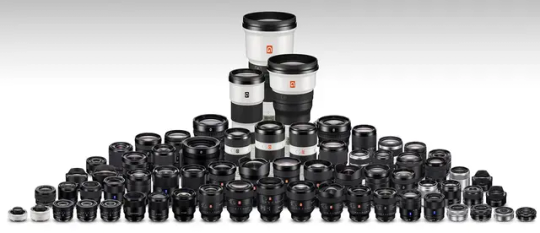
It's a lot of pressure too, because lenses are more important than the camera in a lot of ways. Interchangeable lenses are probably the biggest advantage big cameras have over smartphones these days.
But I think I can help get you up to speed.
The following terms are photospeak you might hear in camera and lens reviews and if you aren't familiar with them, it can make it difficult to figure out what camera and lens to purchase.
I tried to put these in an order that makes sense, but some terms relate to other terms and you may have to read the list twice to make sure you understand how everything mushes together.
Froggie's Encyclopedia of Lens Terms
Lens Mount
Every camera has a specific lens mount. Sony calls theirs the E Mount. Nikon has the F Mount (older) and the Z Mount (mirrorless). So you need to make sure the lens you are looking at is compatible with the mount on your camera.
Mirrorless cameras all upgraded to a mount with a "short flange distance." Going without a mirror allows the lenses to be closer to the sensor.
Long story short...
Short flange distance = easier lens design = sharper/lighter lenses.
However, if you want to use older DSLR lenses, there are adapters for Nikon and Canon that allow you to do that.
Aperture
"Aperture" is an opening at the front of the lens. It gets bigger to let in more light or smaller to restrict light.
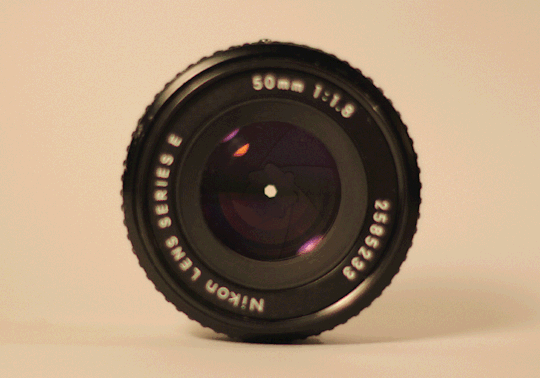
Wider apertures have a shallower depth of field, causing blurry foregrounds and backgrounds outside the plane of focus. Smaller apertures expand the focus area to keep more stuff from being blurry, but they let in much less light and are difficult to use in dark environments.
Aperture can be a creative decision or it can be a technical decision or it can be a mix of both. If you need a blurry background, use a wider aperture. If you need everything in focus, use a smaller aperture. If you need more light in a dark scene, open it up.
F-stop
"F-stop" is a number representing how big the aperture is. A lower number is a bigger hole. Higher number is a smaller hole. It is helpful to memorize f-stops as they are not easily divisible. Cameras generally allow third stops, half stops, and full stops.
These are all a "full stop" apart.

Stop Down/Open Up
When someone says to "stop down" a lens, they are telling you to make the aperture smaller or use a higher f-stop number.
If they say to "open up" they are saying to make the hole bigger or lower the f-stop number.
Depth of Field (DoF)
Depth of field refers to how much of the photo is in focus. Things in front of the plane of focus will get blurrier and blurrier and things behind the plane of focus will get blurrier and blurrier. A shallow depth of field means only a tiny sliver of your image will be in focus. A deep depth of field means almost everything will be in focus.
The wider the aperture, the shallower the depth of field.
The smaller the aperture, the deeper the depth of field.
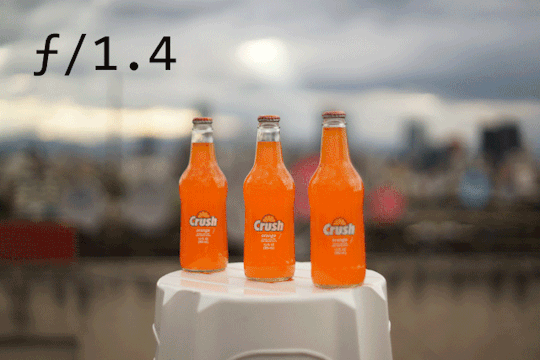
Focal Plane or Plane of Focus
The focal plane is the sharpest point within the depth of field. You can imagine an imaginary section of 3D space where things within the depth of field are sharp and things outside are blurry. The farther away from the focal plane, the blurrier they will get. But the focal plane is not always dead center of the depth of field.
Typically, at close distances, things will be sharp half in front of where you focused and half behind where you focused. As things get farther away, that changes to more 1/3 in front and 2/3 behind. The ratio changes even more at greater distances, but the 50-50 and 1/3-2/3 ratios are typically what photographers try to remember.
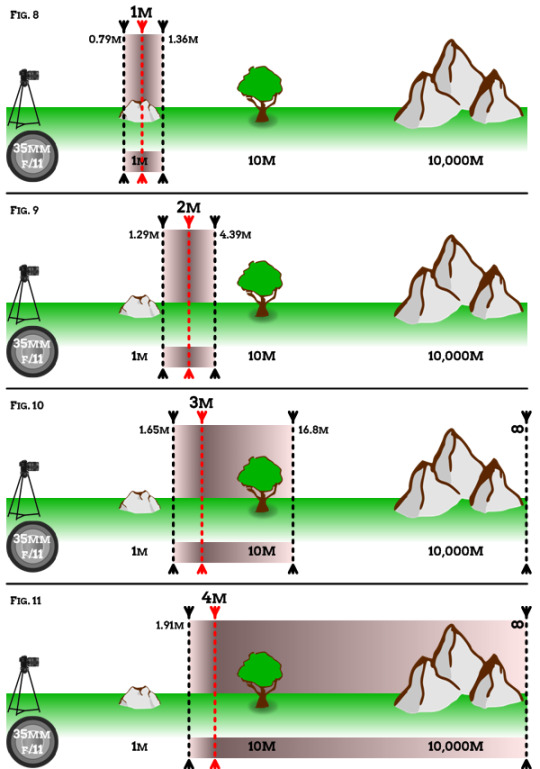
Shallow Depth of Field
The focal plane is something you need to be very aware of at close distances with a wide aperture—as the depth of field can end up as a tiny sliver.
Let's say you are only a few feet away from a baby and you have the aperture set at f/1.2. You focus on the nearest baby eye, and then you notice its ears and nose are out of focus.
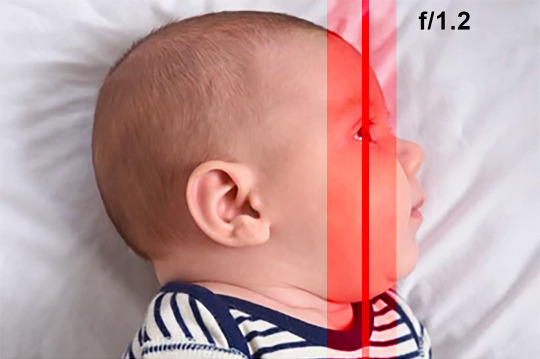
The plane of focus and shallow depth of field are causing this issue. This might be a worthy compromise if you are in a dark room and your ISO is very high and you are worried about too much noise.
However, if you can use a flash or some kind of lighting, you can stop down your lens and increase that depth of field around the focal plane.
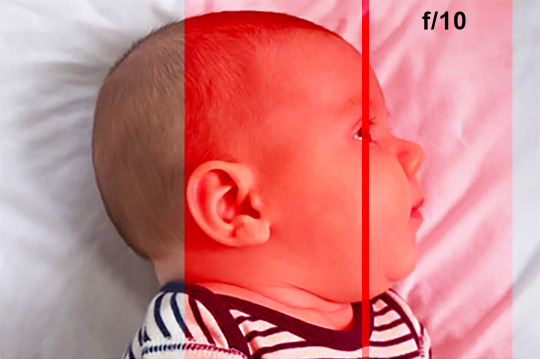
Bokeh
Bokeh is the quality of the blurriness. Some people are more obsessed with how good the blurry parts of the photo are more so than the in focus parts. Bokeh is typically judged by "bokeh balls" which are just out-of-focus lights in the background. While I like attractive bokeh balls as much as the next photographer, I will admit this is one of the sillier aspects of photography.

Field of View (FoV)/Angle of View
This is how much stuff you can fit in frame at a given distance. Wide angle lenses can fit more stuff in at a shorter distance and telephoto lenses can fill the frame with stuff that is farther away. The focal length of the lens determines the field of view. The focal length is designated by millimeters and the field of view by degrees.
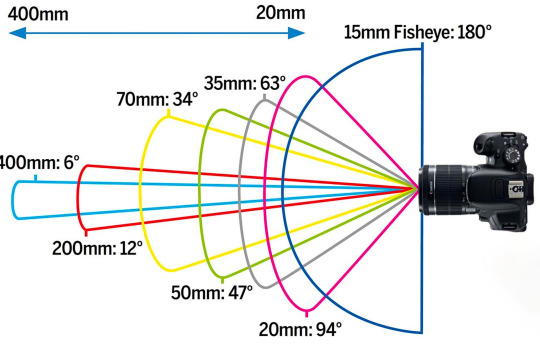
Focal Length
Technically, this is "the distance between the lens's optical center and the camera's sensor."
In simpler terms, this is how you determine the field of view of a given lens.
A short focal length, like 10mm, will have a wider field of view. You have to be very close to your subject to fill the frame with them.
And a longer focal length, like 500mm, will allow you to fill the frame with your subject from farther distances.
Typically all lenses are designated by their focal length. If someone says, "Hand me the 50" they mean a 50mm lens.
35mm Equivalent
Not every camera has the same sized sensor. So when we talk about lenses, we need a reference to help us understand how a given lens will behave. A 50mm f/2.8 lens does not have the same field of view or depth of field when placed on different sensors. So, we need a standard for comparison.
The standard that is used is the "full frame" sensor which is roughly the same size as a 35mm piece of film.
Anything smaller is considered a "cropped sensor."
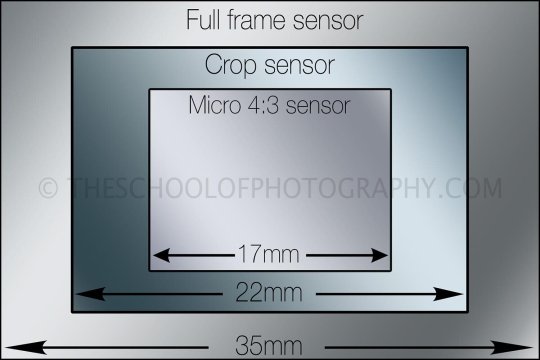
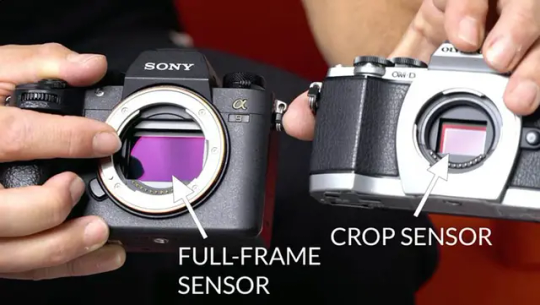
Those cropped sensor cameras have a "crop factor"—a simple multiplier that helps you understand how lenses compare. And when you use this multiplier it tells you the "35mm equivalent."
Confused yet? Yeah, sorry, it would be easier if camera manufacturers chose metrics that didn't change depending on the sensor, but this allows them to make their cameras and lenses seem more impressive in the marketing.
There are two main cropped sensors for ILCs. (Interchangeable lens cameras.) APS-C and Micro Four Thirds. They have a "crop factor" of 1.5x and 2x respectively. The Micro 4/3 sensor is half the size of Full Frame, therefore it has a 2x crop factor. And when you apply this crop factor to the aperture and focal length you can determine how a lens will behave.
For example, a 50mm f/2.8 lens on a micro 4/3 sensor would behave the same as a 100mm f/5.6 lens on a full frame—as 100mm is 2x 50mm and f/5.6 is 2 stops above f/2.8.
As you can see, the Micro 4/3 lens is not going to do as well in low light. The iPhone boasts an aperture of f/1.8 on its main lens, but when you figure out the 35mm equivalent, it's more like an f/8 lens.
I went to all the effort to explain this because it demonstrates that larger sensors allow you to work in cramped spaces with less light. If you want to use a 50mm in a hospital room, you probably can on a full frame. But on a Micro 4/3 you might need to be out in the hall because your lens is acting like it is 100mm. So the Zf would be a good choice in this regard.
Camera Shake
This is the bad kind of blurry. Humans are not tripods, so when you are handholding a lens, you need to make sure your shutter speed is fast enough to freeze the action of your image. Camera shake is very easy to control on wide angle lenses and very difficult to manage with telephoto lenses.
Reciprocal Rule
The reciprocal rule states that in order to get sharp photos without blurry camera shake, you must set your shutter speed to 1 over twice the focal length of your lens. So if you have a 100mm lens, you need to set your shutter speed at 1/200 to be safe.
This rule breaks down at a shutter speed of 1/50 if there is anything moving in your image. So if a dog is running or a car is driving by, it will have a motion trail, but at least it won't be due to your shaky hands.
Image Stabilization
This is a feature some lenses have that helps reduce camera shake. Image stabilization can counteract shaky hands and let you get sharp photos with a much slower shutter speed. Newer cameras have sensor stabilization which does the same thing. And if you pair up a stabilized sensor with a stabilized lens, it is almost as effective as using a tripod.
Stabilization is measured in stops. You might hear a lens has 4 stops of stabilization. That means you can handhold the lens and not get camera shake with a shutter speed 4 stops below the reciprocal rule. So for that 100mm lens, that 1/200 becomes roughly 1/12. And if your sensor has 4 stops, you could handhold a shot for nearly a second without any shake.
However, at shutter speeds that slow, if anything in the frame is moving, they will probably have motion blur. But for still life scenes, or maybe a sleeping baby, this can be very handy if you don't have a tripod with you.
If being able to handhold at lower shutter speeds seems important, then you might want to seek out a lens with stabilization and pair it to a camera with sensor stabilization for maximum stable-osity.
Lens Compression
Lens compression is kind of a myth, but I think we still call it compression because it is easier to explain to beginners than optical physics. The lens doesn't really compress anything, it's actually a matter of distance and the aforementioned physics. But I'm going to go with the easy explanation for now.
Lens compression is a phenomenon seen with different focal lengths. If you take a photo with a 500mm lens, the background will seem to compress with the foreground. Thus objects in the background will seem much larger in size.
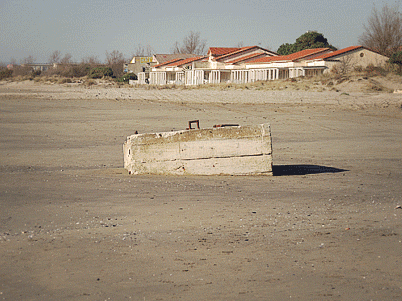
This also happens with faces.

Wider lenses exaggerate distance. At 10mm, the lens would only be a few inches away from someone's face.
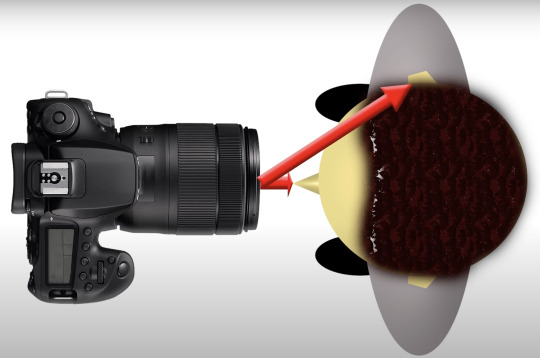
From the lens's point of view, the ears are several times farther away from the lens than the tip of the nose. So the lens is like, "Your ears are really far away! And far away things are really small, right?" So the lens gives us a big nose and small ears and makes us look a bit alien.
But at 100mm, the lens will be several yards away.

From this perspective, the lens feels like your ears and your nose are nearly the same distance away. And the lens is now like, "Things that are the same distance away do not get bigger or smaller." The lens seems to compress or flatten the face, causing a more flattering appearance in the image.
Minimum focus distance
This is sometimes called the working distance. This is how close you can get to your subject while maintaining focus. If you get too close, your camera will just hunt and freak out perpetually until you back up and it can lock on again. This isn't always advertised prominently for lenses, so you need to make sure the lens will be able to focus in the space you plan to use it.
Extension Tubes
Sometimes called "macro extension tubes." These are spacers you put between your camera and lens to decrease the minimum focus distance. In some cases you can even turn a normal lens into a macro lens. These tubes are able to stack and the more you put on, the more into the macro realm you can go. They come in smart and dumb versions. The dumb ones require you to manual focus whereas the smart ones can still use the autofocus system. I highly recommend the smart ones, as they are not too much more expensive.
Lens Imperfections
There are a few imperfections that can plague all lenses and their quality is sometimes judged by how well they mitigate those imperfections. Here are some of those attributes.
Lens Distortion
As lenses get wider, they allow a larger field of view by accepting light rays that are coming from the side of your lens. Let's look at this image again.
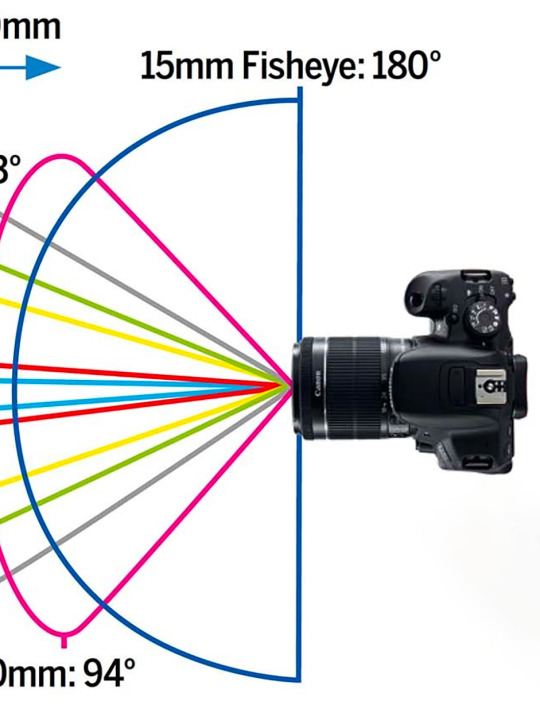
Your lens then has to correct those rays and send them to a square, flat sensor. If you look at the 180 degree fisheye, that entire arc has to be flattened and made square. And as good as optical engineering has become, the wider the lens, the harder it is to keep the image from distorting.
This is typically called "barrel distortion." Minor distortion can actually be corrected in editing software. Every lens has correction algorithms. Though sometimes it is best to embrace the distortion, like on a fisheye lens. Make the distortion a feature and not a bug.
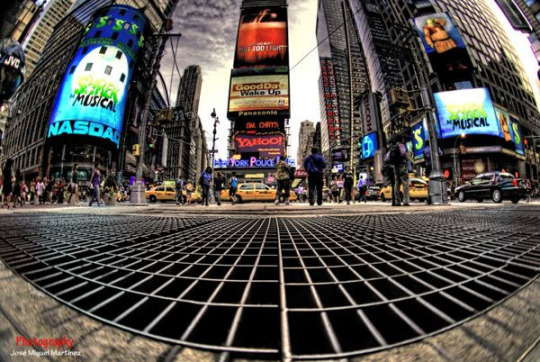
Chromatic Aberration
This is the fancy name for color fringing. This is a defect in the lens that cause false colors to contaminate certain objects in a photo. Typically this happens around dark skinny things against a bright background, such as tree branches.
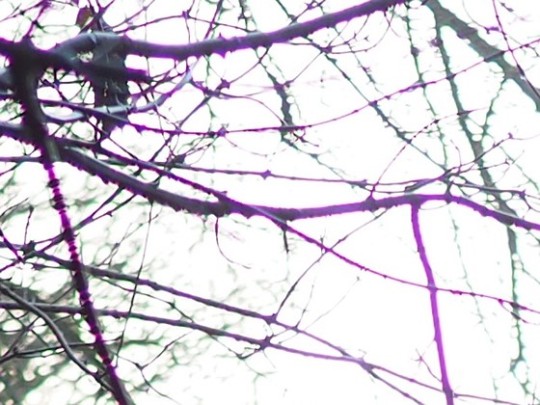
Modern lenses have nearly eliminated this, except for the super cheap models, but if you do end up with fringing, this can be easily corrected in Lightroom or Photoshop. And many lenses even have that correction built in and all you have to do is check a box.
Sharpness
You might not think of sharpness as an optical flaw, but no lens is perfectly sharp. And the quest to make a perfectly sharp lens involves engineering those optical flaws to a minimum.
A "sharp lens" is one with incredible fidelity. Even zoomed in beyond 100%, sharp lenses will show great detail. If you can't get close to the subject and need to crop your photo later, having a sharp lens can make up for the loss in resolution—as you can upscale without much loss in quality. If you plan to make large high quality prints, a sharp lens will help more than tons of megapixels.
That said, if you truly want to get the most out of a high megapixel camera, a sharp lens comes in handy here too. A smartphone may boast in the marketing as having 200 megapixels, but it has a tiny plastic lens. So even though it technically has 200 megapixels on the sensor, the lens will give it the equivalent of maybe 8-10 megapixels worth of detail. People forget, the lens has a resolution as well, and if the lens cannot resolve 200 megapixels, you aren't going to get a 200 megapixel image.
A sharp lens will allow for more detail than higher megapixels. In some cases you need to double or triple the number of pixels to see an increase in detail. Whereas you can put a super sharp lens on a 12 megapixel camera and blow any smartphone out of the water.
And if you put a sharp lens on a 50 megapixel camera, you can almost see into skin pores.
So... sharp = more detail. And more detail gives you greater cropping power for when you can't get close to babies.
Now, I am obligated to say that some photo nerds chase sharpness as if it is some holy grail. They need the sharpest lens so all of their pixels are perfect at 100% zoom even though no one ever looks at an image that close. There are amazing photos that have been blurry. There are amazing photos taken with 50 year old vintage glass. Sharpness is just another tool. If you need to crop. If you need to upscale. If you need to print large... it is a great help. But nearly every lens made for a modern mirrorless camera is "sharp" to some degree.
So, if you need extra sharpness for certain situations, do your research and find a lens that is sharp as can be. But sharpness should be like 8th on the list of priorities.
Soft Lens
A "soft" lens is how a non-sharp lens is referred to. Most modern optics for mirrorless cameras have some degree of sharposity.
Sharpitude.
Sharp...ness.
So you don't need to worry too much about getting a detrimentally soft lens unless you go super duper budget. This is why I usually recommend people skip the "kit lens" unless they absolutely can't afford anything better.
Though sometimes people purposely get vintage lenses because they don't like sharpness and prefer the "character" of older lenses. The imperfections can achieve a different artistic goal. Though this can also be achieved through lens filters... or Vaseline.
I'm looking at you, Barbara Walters.

Sharpness at the Corners
When I read that in my head just now I said it the same way I do "Panic! at the Disco."
Engineers will prioritize sharpness at the center of the lens since that is where most of the interesting stuff tends to be. But also, the light rays at the center tend to be the most parallel as they head to the sensor, so they don't need as much correction. The rays coming from the sides have to be bent and manipulated to correct for distortion, so keeping things sharp at the corners can be a challenge.
Now, knowing that, and knowing how the aperture works, you can infer that when you stop down your lens and make the hole smaller, all of the light rays are constricted to a smaller area. This makes them easier for your lens to deal with, so if a lens has problems with corner sharpness, you can usually stop down to improve this. So if a lens is soft at the corners at f/1.8, you might be able to go to f/2 or f/4 to get better results.
Vignetting
Vignetting is a circular area of darkness at the perimeter of your photo. This is another side effect caused by the same things as soft corners. When correcting those non-parallel light rays, it causes them to travel an ever so slightly farther distance getting to your sensor. And the inverse square law tells us that light becomes dimmer as it travels longer distances.
This is very easy to correct. Usually your camera has a setting to correct vignetting if you are outputting JPEG files. And if you are shooting RAW photos, your editing software should have a check box to fix the vignetting—usually the same one that fixes chromatic aberration. This is usually called "lens correction" in most menus.
Also, same as with corner sharpness, stopping down your lens will usually fix this optically rather than with software algorithms.
Contrast
Contrast is probably the most important attribute to determine lens quality. Good contrast can make a soft lens look good. But lens contrast is not always consistent. It can get better or worse depending on the lighting in your scene.
The best way to test the contrast of a lens is to take a picture of something that is backlit. A person with the sun behind them is a great indicator. If they have no light on them, the person should fall into inky darkness. But if a lens has poor contrast, they will seem like a faded gray.
Focus Breathing
Focus breathing is a phenomenon where your focal length changes depending on how far away your subject is. It's usually not a big deal and most people don't even notice it, but if you ever do video, it can cause a few headaches. Some people can get annoyed because they feel they aren't getting the advertised focal length on the lens they bought. Like, if you get a 300mm lens and it only goes to 250mm for things super far away, that can be annoying.
This video explains it in detail.
youtube
Lens Types
Prime Lens
A "prime lens" has a fixed focal length and cannot be zoomed. Typically prime lenses are "faster" (wider max aperture) and sharper. Weirdly they can be very inexpensive or the most expensive. They can be extremely lightweight or weigh a ton. And if you want the sharpest lens possible or the fastest lens possible or both, it will be expensive and heavy.
Having at least one fast prime is usually recommended for any professional photographer.
Zoom Lens
A "zoom lens" allows you to zoom. Obviously. But there are few that go below an aperture of f/2.8, so less light gathering and you sacrifice a bit of sharpness. However, if you don't know how much space you will have to work with, the flexibility of a zoom can be invaluable.
Be warned, while a cheap prime lens can still take fairly good photos, cheap zooms are usually pretty terrible. There are plenty of reasonably priced zoom lenses to choose from, but if the price seems too good to be true, I would trust that intinct.
Wide Angle Lens
A "wide angle lens" is any focal length below 35mm. Wider focal lengths allow you to get more stuff in the photo at shorter distances. A theme you might notice with photography is that every benefit has a compromise or consequence to go with it. Wide angle lenses are wonderful if you are in a cramped space. They also make it easy to keep everything in focus. But as you go wider, distances become exaggerated and barrel distortion becomes more pronounced and harder to correct.
Things that are close to the lens seem huge and things farther away seem tiny. One trick to remember is things in the center of the frame will be less affected by distortion. Something to take into account when taking those smartphone selfies.
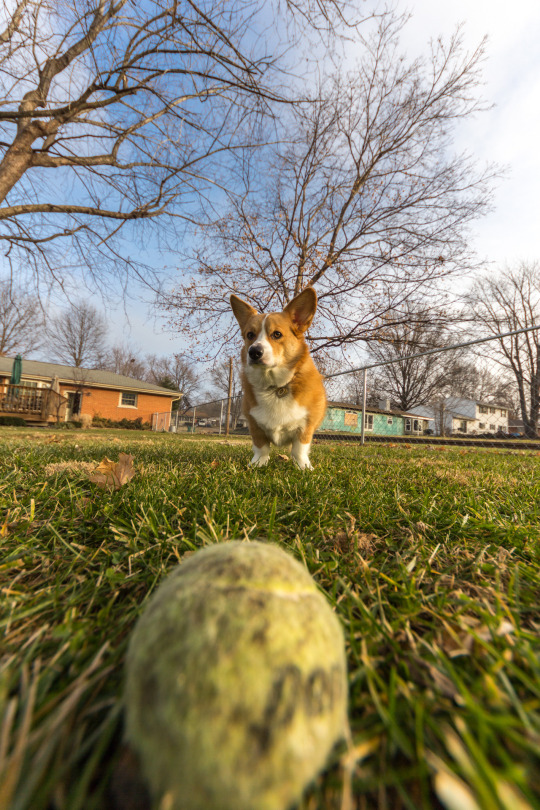
If you look, the ball looks huge in frame because it was only a few inches from the lens. Otis was literally smaller in frame than the ball despite only being about 2 feet away. However, he doesn't look all stretchy like the ball because he is centered.
Standard Lens
A "standard" or "normal lens" represents about the same field of view as the human eye. Generally around 40mm to 55mm on a full frame camera (there is some debate on this, but close enough). This is right about where you can take pictures of faces without the unflattering side effects of wide angle.
Telephoto Lens
A "telephoto lens" allows you to stand farther away and still fill the frame with your subject. Usually lenses 200mm and above are considered telephoto. These are often heavy and expensive.
Specialty Lenses
Ultrawide
This is just an extremely wide angle lens. At this point, you just except the massive amounts of distortion and embrace it. These lenses are extremely fun.
Medium Telephoto
These are sometimes called "portrait" lenses as well. They are a little more tele than standard and not quite tele enough for long distance photography. Usually in the 70-200mm range. This is the focal range that allows you to still be close to your subject but you are far enough away to get extra flattering lens compression on faces.
Superzoom Lens
A "superzoom" has an extremely large focal range. It can go from very wide to very telephoto. These are usually not wonderful lenses, although they have improved on mirrorless cameras in recent years. There are a few that could even be used professionally now. But most are just a huge mediocre compromise for vacation pix.
The cheap ones aren't fast, they aren't sharp, and every time you zoom people think your camera is having an erection.
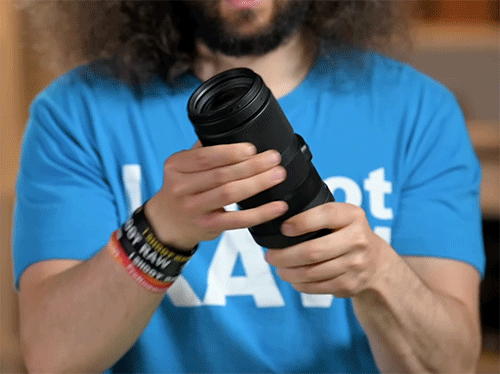
If you are traveling and you have no idea what you might be photographing and carrying around a bunch of lenses is impractical, these have utility. But the larger the focal range, the more mediocre they get. Typically if the zoom range exceeds ~150mm you will start noticing that mediocrity. So a 70-200mm can be fantastic. But an 18-300mm will be very mid.
Macro
A macro lens is any lens that has 1x or more magnification. 1x magnification is a designation that relates the sensor size to how much of the subject fills the frame of your image. For 1x, that ratio should be 1:1.
So if you imagine a quarter lying on top of an image sensor, that's how big the quarter should be in your photo. 2x magnification would be like if a quarter doubled in size and you laid it on top of the image sensor. And so on.
Beware of lenses claiming to be macro and really only having a short working distance. 0.5x is not macro, but is sometimes advertised as so.
Tilt Shift Lens
This is a very niche lens. Most people know of it from the photos that make everyone look like they are in a miniature land.
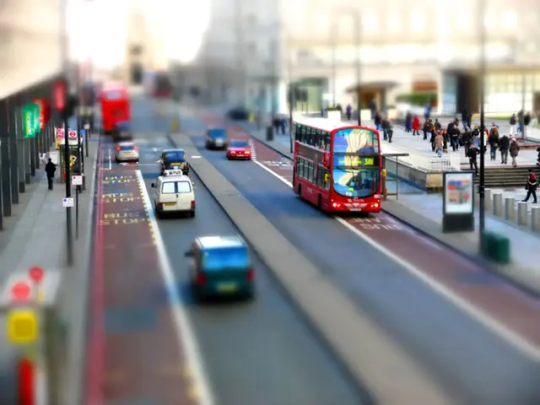
For every other lens, the focal plane is perpendicular. If you move the camera at an angle, the focal plane will match that movement. So what the tilt shift lens allows you to do is angle the focal plane so your depth of field goes in bonkers directions.
Product photographers love this because you can take a photo of an array of products from a 45 degree angle and keep everything in focus.
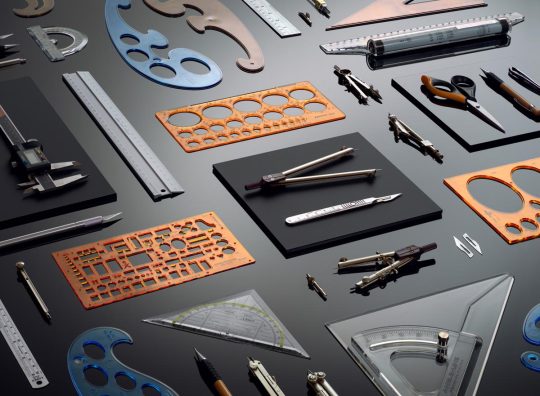
This image would be impossible to maintain complete focus of all the objects without a tilt shift lens.

In this example, without tilting the lens, the tip of the multitool is out of focus.

And now you can see the camera hasn't moved, but the lens is at a steeper angle. And you'll also notice the entire tool is in focus.
But wait, there's more! Did you forget about the shifting? Architectual photographers can use the shift function of the lens to correct perspective distortion and keep buildings looking straight.

Will this lens help in the photographing of infants?
Probably not.
But I bet you thought it was cool and are glad I included it.
Recommended Essential Lenses
I didn't know what to call this section. These are just the collection of lenses most photographers will try to acquire as they build out their kit.
Nifty Fifty
This is probably the first lens everyone should buy. Almost every brand has their own version. It is an inexpensive 50mm lens with a sub f/2 aperture. Canon's Nifty Fifty or "Plastic Fantastic" is probably the most famous example. It is only $125 and has an f/1.8 aperture.
This lens may not be the sharpest and it might have a lot of plastic-y, cheap feeling parts, but it is a wonderful way to get started with photography. You can use the wide aperture to experiment with bokeh and shallow depth of field. And the 50mm focal length is probably one of the most versatile. Not too wide, so people look normal, and not too tele, so you aren't a mile away from your subjects.
The Holy Trinity
The "Holy Trinity" is meant to describe the 3 lenses that can handle nearly every photographic task while maintaining professional quality results. Typically these lenses are all f/2.8 and are high quality zoom lenses. The 16-35mm, the 24-70mm, and the 70-200mm.
Most photographers can accomplish just about any task with these lenses in their bag.
Froggie's Holy Hexagon
That said, if I had an unlimited budget I would actually have 6 lenses to cover everything. Beyond the Holy Trinity, I would get a fast prime, an ultrawide, and a macro lens.
A fast prime can see in the dark and has more background blur. The nifty fifty would work great for this.
An ultrawide is one of the most fun lenses you will ever use, even if it distorts everything to a crazy degree and isn't useful very often. It is great for breaking you out of photographic ruts and can really get the creative juices flowing.
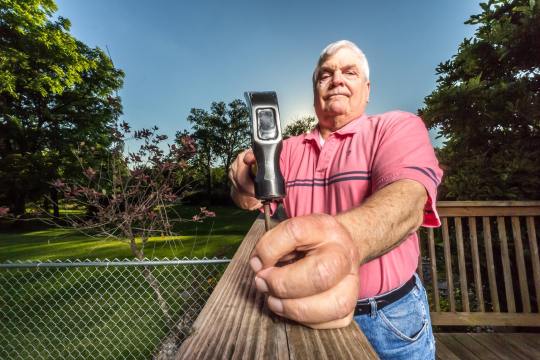
And a macro lens is not just useful for making tiny things big. It also allows you to focus at any distance. Sometimes you just need to get a tad bit closer than your other lenses will allow. Macro lenses are also pretty great portrait lenses and can serve multiple functions.
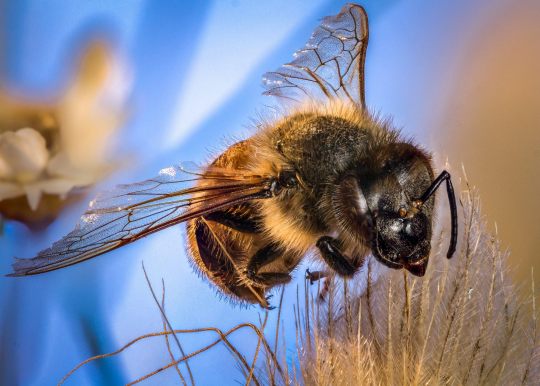
And if anyone is interested in sports or wildlife photos, a nice telephoto lens might be a seventh lens to consider.
I think that is the end of part 1.
I hope this was helpful. And I look forward to posting part 2 soon.
89 notes
·
View notes
Note
hi ur cute and also btrfs worked really well for me to stripe all my 1 tb hdds into a big blob and zfs fought me so i think btrfs is pretty cool. the only OS partitions ive ever btrfs'd was my brother's steam deck but i probably would in the future
i don't use that feature but yea, btrfs lets you do some cool stuff combining volumes! and having btrfs on your os partition is really useful, since you can then quickly restore a snapshot if something breaks
4 notes
·
View notes
Text
Image 1:

Image 2:

Got this idea after a personal chat with SkyKain :iconskykain: and acknowledged that Globi, Ratly, Waffle, and Gutty (their OCs) are game and cartoon nerds XD
First image:
- Prominently featured with Ratly along with the aforementioned gals (as icons).
- Definitely inspired by Random CS:GO Bullshittery (part 3) by SovietWomble of the ZF Clan.
- As for the songs they are singing:
1) Shut Up by Black Eyed Peas (Globi and Waffle)
2) Shut Up! by Simple Plan (Waffle)
3) One Step Closer by Linkin Park (Gutty)
Second image:
It’s time for @skykain’s gamer gals once again 😆 This time I imagine them as if they play Left 4 Dead series via VR or with their own advanced hologram ;)
From left to right: Gutty, Ratly, Waffle, and Globi.
- Each of the gals also use other weapons apart from what I've portrayed here.
- If Waffle wanna use a flamethrower, she has to install certain mods, lol XD
#skykain#skaven#anthro#video games#gamergirl#original character#left 4 dead#ratly#gutty#globi#waffle
24 notes
·
View notes
Text
eruhan family
my most ambitious modern au headcanon for my most precious rarepair, the lineup for their children was finalized 230911 bcs 9 kids soothe my eyes

the family tree: hange-smith


the parents: erwin smith and zoe hange
bit of a background: they were classmates during kindergarten and he immediately grew a crush on her, but he had to go back to the UK due to his family's business. they met again during college and immediately hit it off and started dating despite a 3-year age difference.
hailing from a big family, zoe wanted to recreate it; crushing on zoe so hard, erwin wanted it too.
he eventually inherited his parents' companies and she became a scientist in many fields.

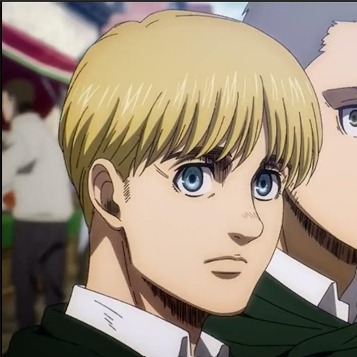
irish twins: eren and armin
while eren was planned, armin was definitely NOT. the former was a honeymoon baby while the latter... well, blame erwin! they have a 1-year age gap.
zoe thought of their names because she wanted it to sound like erwin's name. eren's green eyes are from both his grandmothers' eyes which made him all the more adored while armin took all of erwin's features, making him erwin's favorite. zoe was the main caretaker of the two but they're undeniably daddy's boys.
eren will be a firefighter and armin the sole heir of erwin's businesses.

the golden child: sasha
sasha was born 5 years later, inheriting all of zoe's features which erwin absolutely loved, making him see that she does no wrong in his eyes.
the couple decided to concentrate on the irish twins before having her who was her brothers' dream come true since they had been wishing for a sister. she's spoiled rotten and eremin does not allow her to do any household chores despite teaching her how. zoe was her main caretaker but she's both a daddy and mommy's girl.
she'd grow to be a baker and open her bakeries.



the triplets: pieck, marcel, porco (PMP)
6 years after doting on the favorite child, the couple decided it's time for another, although this time, they didn't expect it to be triplets. while they were overjoyed, zoe's siblings were stressed for her but erwin's parents were excited for them.
pieck had her the hair color of zoe's mother, but both grandmothers and zoe's sister declared her as their favorite, also armin's because she's smart; marcel is eren's favorite because he's very diligent, quiet, and observant, ever the peacemaker; porco is sasha's favorite because he used to follow her around and obey her every request just to get her approval. erwin is their main caretaker but they're very much the babies of their eldest siblings.
pieck would grow to be a journalist, marcel a diplomat, and porco an air force member.


fraternal twins: zofia and falco (ZF)
after 4 years, the couple again didn't expect they'd have another set and zoe's OB wanted to smack the shit out of erwin.
erwin named zofia because he wanted something similar to zoe's name while armin named falco because he felt like it. the triplets joked that the ink went dry with the twins' hair (and the two absolutely believed it). falco adores eren the most while zofia idolizes armin so much even if he's always making her cry for the fun of it. erwin was their main caretaker but the triplets helped the most.
zofia would be an astrophysics major and falco a literature major.

youngest: ymir
the result of erwin's request to zoe 7 years later and she agreed because she also missed having a baby in the house.
eren named her and declared her the sister he didn't know he was missing, she's closest to him and the twins; her grandparents liken her to a cat because she's always curled up with her parents. shy and distant with the triplets, the couple were her main caretaker with the rest of the siblings helping out.
she'd grow to be a pediatrician.
#eruhan#eruhanfamily#familytree#introduction#aot#erwin#hange#eren#armin#sasha#pieck#marcel#porco#zofia#falco#ymir fritz
7 notes
·
View notes
Note
Axioms of Set Theory? That's a really cool name for a wip I have to say
AXIOMS OF SET THEORY IS ONE I'M EXTREMELY EXCITED FOR AND IS DEFINITELY HAPPENING
it's a jjk fic, a "okay but what if you make Gojo actually actually a mathematician", it's a bunch of disconnected slowly-getting-more-connected scenes in a one-shot but under headings in a 5+1 style of fic except. you know. the 8 Axioms of [ZF] Set Theory+ 1 Axiom of Choice and, like, funnily enough has ended up with extreme everything everywhere all at once vibes?
major spoilers for jjk s2 below the cut for snippet
The Prison Realm, in its own way, is sort of like death.
A long time ago, when he was on the brink of death, he thought he understood cursed energy in its entirety. Cursed energy was negative energy. The way that you get a positive from a negative was multiplying it by another negative. It was so simple, so elegant; he finally understood reverse cursed techniques.
He should have understood that that was middle-school math.
He stares out into the blankness, the infinite dimensional space between dimensions.
And then he gives it a basis.
#there's another really funny snippet featuring alice and bob#(which if you've done any number theory or cryptography you know are the base names that your theoretical people communicating are given)#but that's too long to make a good snippet#my writing#legitimately I am extremely tempted like this is a one-shot but to write it with a second chapter that is#'here are explanations for all the math that is referenced'#gods going to laugh SO hard if the first fic that I write that needs footnotes is not xianxia fic#but is for somewhat advanced set theoretic concepts
9 notes
·
View notes